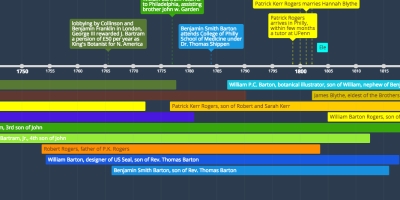13 oct. 1841 - Henry D. Rogers
visits Maunch Chunk
b.w.o. Reading, Pottsville
Description:
https://archive.org/stream/cu31924012485391/cu31924012485391_djvu.txt
FROM HIS BROTHER HENRY.
Philadelphia, October 13, 1841.
My dear William, ... I returned to town yes-
terday after a tour of eleven days with Mr. and
Mrs. Lyell and Mcllvaine. We went by the way of
Reading to Pottsville, Mauch Chunk and Beaver
Meadows, returning by Easton and the Delaware,
through Trenton. If Lyell has been half as well
pleased and satisfied with me as Mcllvaine and I
have been with him and his accomplished wife, I shall
congratulate myself. I deem him a man quite too
high-minded to encroach on the literary rights of
others, and have many kindly feelings toward him for
the friendly interest he has shown in our future scien-
tific progress. Lyell came over at the invitation of
Mr. Lowell, and intended to return in December, but
now means to remain a year. This of itself shows
how much our geology, and of course the exploring
JEt. 37.] GEOLOGY, 195
of it, can interest the Europeans. His plan is to go
South through the Tertiary after his course of lec-
tures, and in April to return North and proceed at
once to Canada and Nova Scotia, where he will be
at work until July. One grand object with him will
be a comparison of our Atlantic Tertiary with the
European, to test the applicability of his nomenclature
to this country. Having seen so much of the Tertiary
of Europe, spending one entire summer in the Crag
of England and all last summer in the South of
France, he is perhaps, of all the English geologists,
the best fitted to establish the true relationship of our
tertiary beds to those of the old hemisphere. To this
delightful task Conrad has shown himself unfitted by
his preference of the closet to the field. It will gratify
you to hear that Lyell already pronounces the beds
we have always named Miocene to be truly such.
After his return to Europe he will probably read a
paper on this whole subject, and I gather has an in-
tention of reading a memoir also on the Geology of
Canada and Nova Scotia. Speaking of the latter, he
expressly told me he would avoid describing the or-
ganic remains which might be common to the New
York lower rocks until Conrad's labours were pub-
lished, unless, indeed, these were so delayed as to im-
pede the progress unnecessarily of all research. . . .
Lyell thinks there is a close and even remarkable re-
lationship between the silurian and our Appalachian
fossils ; also between the coal formations of the two
countries. Now, as to the gradations from the silurian
fossils into the coal fossils, — perhaps the most inter-
esting problem of all, — we may take this, if we are
diligent, into our own hands by collecting largely
from the marine limestones of our Western coal-fields,
and from the silurian beds in For. XL and that por-
tion of the series. Li order to do this, Lyell recom-
mends us to procure the new work just published by
Phillips on the Devonian fossils, in which he has been
aided by the English government. Having Murchison
196 GEOLOGICAL SURVEY OF VIRGINIA. [1841.
on the Silurian and Phillips on the Mountain Lime-
stone, we have only to procure this last and collect
largely and we shall have the whole subject before
us. . . .
Ajouté au bande de temps:

Bartram Barton
Date:
